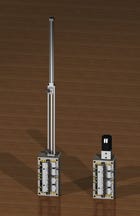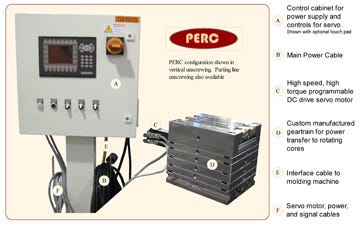The long and short of an
unscrewing mechanism
If necessity is the mother of invention, it surely applies to the PERC system. Its inventor needed a way to solve a huge problem for a customer—and invented it.Unscrewing molds can be a bear to operate. Conventional unscrewing molds are hydraulically driven, and the number and size of the threads on the part dictate the number of revolutions the core must rotate before the mold can open. The number of rotations necessary then determines the length of the hydraulic rack and the size of the hydraulic cylinder.
April 20, 2010
If necessity is the mother of invention, it surely applies to the PERC system. Its inventor needed a way to solve a huge problem for a customer—and invented it.
Unscrewing molds can be a bear to operate. Conventional unscrewing molds are hydraulically driven, and the number and size of the threads on the part dictate the number of revolutions the core must rotate before the mold can open. The number of rotations necessary then determines the length of the hydraulic rack and the size of the hydraulic cylinder.
|
That’s all well and good until a customer comes to you with a part that has so many threads that the rack (which is mounted to the mold) has to be unrealistically long in order to unscrew the part from the core. “For example, a part that requires seven to 10 rotations would need a rack 15-20 inches long, but a part that requires 20 turns would need a much longer rack!” comments Alan Petrucci, founder of B A Die Mold (BADM; Aurora, IL).
With a conventional unscrewing mold, gears would be used to step down the length of the rack. “This works with many threaded parts, but not all,” says Petrucci. “The gearing necessary can take up a lot of real estate in the mold base, which becomes an issue and creates limitations when there are other actions necessary for other features on the part or if the processor needs to fit the mold into a particular size press.”
There had to be a better way, Petrucci figured, when a customer came to him with a part needing precision positioning—not so much for the number of threads, but because one core had to pass through another. “One core was threaded and had to reset again, while another went through it,” Petrucci explains. “Also, it had to be flashless because it was a water filtration application. The customer was stuck having to make the part in two pieces, and I foolishly said, ‘I think I can make it in one piece.’ That’s how I got the idea for the Programmable Electric Rotating Cores (PERC) System.”
It’s official
In March, Petrucci and BADM received their formal patent on the PERC System. The company has been making molds with the PERC System while awaiting patent approval, and even built systems for molds being built by other shops. “Since then we’ve made molds with 30 turns to a core—conventionally you’d need a basement below the press and a retractable roof above just to run this,” said Petrucci.
PERC eliminates the need for a rack by using a servomotor to rotate the core. That means parts with virtually an unlimited number of threads, intricate geometry, or special requirements are now possible and practical. Eliminating the hydraulic cylinder also eliminates the hydraulic cylinder mess.
|
In one automotive application where the customer needed a rack for a mold that was too large for BADM to handle, the latter built the system and then helped the moldmaker install it. “They needed the molded plastic bottle for the fluids for under the hood,” Alan says. “They were molding the top half of the bottle, then the bottom half, and sonic welding the halves together. They needed threads in the bottle and that required a very large rack and cylinder system, which meant they couldn’t get the mechanics in the press with the mold because they needed tons of room. Someone at that mold shop found out about us and called, so we built the systems for four molds, trained them how to use them, and they’ll never use rack and cylinder again.”
The all-electric servocontrolled PERC System offers higher energy efficiencies than its hydraulically driven counterparts, Alan says. For this reason, some of BADM’s customers specify PERC even when the unscrewing can be effectively achieved with a conventional hydraulic rack and cylinder. Another benefit is that the PERC System is fully programmable and extremely accurate, he adds. “You can program an unlimited number of profiles and repeatability is absolute. It’s perfect for electric molding machines—the controls for the PERC System can be integrated/hardwired right into the press, much like a core pull function.”
The start of a new technology
Petrucci is now considering his next step with PERC. There are a few options, such as licensing PERC, or building the PERC systems and supplying them to other moldmakers to incorporate into the mold. “We make a kit—gears, cores, bearings, and design,” he notes. “There were several applications where the molds were just too big for us, so we helped [our customer] design the mold to accommodate our system and sent our moldmaker to install it.”
One of the first big tests for the PERC System came from molder/moldmaker Toledo Molding & Die (TMD; Toledo, OH). Jim Pierce, engineering supervisor for TMD, required a four-cavity mold that needed an unscrewing core. However, once Pierce began looking into what it would take to make this unscrewing mold in the traditional way, he realized that the cylinder would be extremely long.
“I knew the production people wouldn’t be happy with the mold, and our company would have to live with the mold for years,” says Pierce, who searched the Internet for an alternative.
“I came across the PERC System, which at that time was brand new and in the patent-pending stage,” Pierce explains. “But I contacted B A Die Mold and told Alan what I needed. He wanted to build the whole mold at first, but discovered he couldn’t because it was too large for his capabilities. Then he didn’t want to build it at all. We finally reached an agreement that he would build the PERC System for us and fit it to our mold.”
That first program for TMD took the collaborative efforts of TMD, which designed the mold and manufactured the majority of it; Osco, the manifold supplier; and BADM. The build had to be carefully coordinated, but in the end it all came together, Pierce says.
As with any new technology, TMD was leery of the PERC System at first, he notes. The control had to be wired into TMD’s press and set up just right—and BADM helped with that. “I went down for the first setup of this mold and helped set the core heights to the correct height to get it ready for the first run,” says Pierce. “It worked flawlessly from the first shot. During our first runs, no one even paid attention to the system—it just ran. Nobody was concerned about the unscrewing core.”
TMD discovered a shutoff condition, so it changed the shutoff. “That was something we learned through the process to make it a better condition for us,” Pierce explains.
Repeat business
A couple of years later, the customer wanted the next generation of parts that required the same type of unscrewing mechanism. Again, Pierce called BADM to build the second system. The second-generation parts mold has been in production for two years, and Pierce says he hasn’t had one complaint from the molding techs. “We’ve gotten over the initial fear of new technology—once you figure out that it works, it’s a great tool. We’ve never had an issue with any of the electronics. It’s plug-and-play with some training—it’s key to get training at the plant where they have to operate it. Once they find out how simple it is, the rest is easy. I think B A Die Mold truly has a better mouse trap.” —Clare Goldsberry
About the Author(s)
You May Also Like






